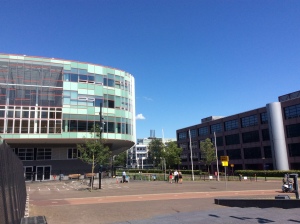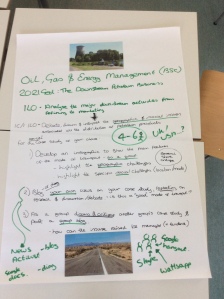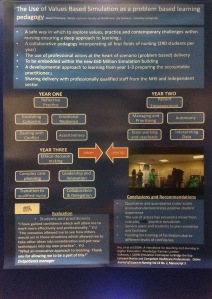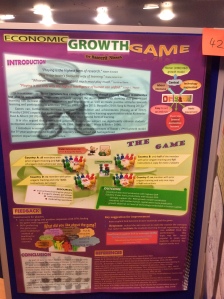I found Adobe Slate after the MO3 Poster Presentation day after a member of my group (check out here twitter handle – she has some awesome ideas: @CUMediaSkills) raved about the range of Apps the Adobe now had that were excellent for teaching, learning, communication and creativity.
Adobe Slate (slightly annoyingly) only works on iPad. But it is a tool for create stand-out stories through imagery and motion (according to their publicity blurb!). The user can add text, photos and links. You then choose how to “animate” it by choosing one of a range of themes, altering the focal point of your images, altering the position of the text (and its font/size/style) and photos to your hearts’ content. You can then share the story via the Slate site, various social media sites or by emailing it or embedding it in a blog. It creates a really nice presentation.
It took me about 15 mins to create a Slate about my recent ultra running adventure at the Ultimate Trails 55km race in July. Whether you’re interested in the tool and what I was able to do with it or my running exploits then you can click here to have a look.
Microsoft Sway which I was introduced to at an Faculty innovation day, works on the same principle as Adobe Slate, but it works on multiple platforms (ipad android and can be used from a PC/tablet internet browser). But the aim is to create interactive, creative reports and presentations. It doesn’t quite have the flow that Slate does, but it allows you to drag and drop existing presentations or word documents into the App/cloud and then you edit them, their style, focus and progression as you see fit. The browser based version allows a much greater degree of flexibility in importing and editing than the App does. It is cloud based to you can then access your Sways wherever you are. I created a rather rubbish one (took about 3 mins!) but it might give you a vague feel for the look and feel of the type of thing that can be created: go here
I thought these tools might be an excellent tool for student assessment and an alternative approach for me or students to create resources (i.e. an alternative to PowerPoint). I’ve discussed fieldwork before in a previous blog here. I discussed that in the field of oil, gas & energy management it is difficult to collect data in the same was as a biologist or geographer might. As a result I made changes to the trip, but it is still what Fuller & France (2014) refer to as a Cook’s Tour field trip i.e. more “look and see” observational trip than an experiential trip. Annoyingly their papers are not an open resource, but you can find the full reference if you look at my poster in my blog here. We know from people such as Kolb (1984) that active learning, learning by doing is vital because it engenders deeper learning through engagement and reflection/experience. With a” look and see” trip, even if skills and practical knowledge are built else where, there is a risk of students becoming passive and not learning anything at all. I have seen this from those that trail along at the back with their headphones in or just ambling along and have to be more strongly encouraged to listen to what is happening.
As I explained in my last field trip blog my students tend not to come from a biology/geography background so their field skills are limited. This makes their life harder when they undertake their second year trip to Dorset, where they are required to make field sketches of petroleum geology sections. Fieldwork is not all about making sketches, using quadrats and counting the different forms of dandylion (sorry have forgotten its proper name!). The skills needed such as observation and attention to detail are required in jobs such as auditing, whether it is quality, health and safety or environment. All roles my students are interested in. It is therefore important that we help them build these skill and increase their engagement with them.
So how can I integrate this into my trip? And how do Slate & Sway fit into this….? Fuller & France (2015), on trip around New Zealand, asked students to compile a video dairy to summarise features and processes, draw at least one field sketch per site and to take ownership of course content. I initially thought about using videos as Fuller & France (2014; 2015) did, but my students are in their first semester of their first year. It may be a valuable skill that can be used in employment, but I think that asking them to cope with a new places, new people, new ideas AND a new potentially complicated technology (not just in taking video footage, but then editing that footage) might be one step too far. Furthermore the ability to communicate is the key tool needed in any job role. Helping students at this stage build their confidence in communication, before adding too much complexity I personally think is important. While video focussed, the principles outlined in France & Wakefield (2011) are really useful for both staff and students in setting up and then delivering digital stories.
Slate & Sway, or even PowerPoint, offer a different, easy to use way to create a photo diary or story that can still achieve the same aim of engagement. My students will be required to collect a series of photos, taking site and personal permissions and privacy into account where necessary, for each activity in their 3 day trip and add narrative to explain the images and how they relate to the topics seen/discussed in class. This, I hope, will force (encourage??) them to focus on the processes being explained, then to reflect more on it and its significance than if they just listened to it being explained. It seemed to work for Fuller & France. I’m hoping it might work for me and my students.
I was also interested by what Fuller & France (2014) had to say about getting students to lead a field activity each and by what the session leader on Microsoft Sway about using Sway (or Slate) to create short presentations. Martin suggested using Sway for flipped learning and Slate & Sway could be used by students to develop pre-field work activity sessions that students could look at in advance or revisit while in the field (assuming they all have a mobile device with internet connection) for support. I will certainly try using them for my Level 2 renewable energy module. I run the majority of these sessions as an interactive session. But I usually spend the first 20-40 mins reviewing the topic and outlining the activity. This could easily be done in Sway or Slate, posted to the VLE then we get to spend the full 2 hr session on the activity and reflecting on the outcomes. The latter tends to become truncated as we run out of time and is probably the most important part of all.
Although I haven’t used either Slate or Sway in anger yet I can see two potential issues.
- Dealing with student’s writing in terms of checking for plagiarism and providing feedback
- submission of PowerPoint, PDF or Word allows for both of these via Turnitin. Providing feedback is easy enough as I can do it via a voice recording or screen cast. But I’m not sure how internal and external moderators will feel about the lack of a similarity check. They’ll have to rely on my knowledge of the students and their writing ability I guess.
- Ideally I think it would be good to have Slates & Sways that can be downloaded to a PDF, which can then be uploaded to Turnitin.
- Presenting while not being tied to the lectern
- I personally like to wander around the room while I speak, with PowerPoint I can use my remote clicker thingy to change slides while I wander. I’m not sure that Slate & Sway have the same functionality.
Some refs.
- France, D., Wakefield, K., (2011). How to produce a digital story. Journal of Geography in Higher Education, 35 (4), 617-623.
- Fuller, I.C., France, D. (2014) Fieldwork Going Digital, Developments in Earth Surface Processes, 18, 117-130.
- Fuller, I.C., France, D. (2015). Securing Field Learning Using 21st century Cook’s Tour. Journal of Geography in Higher Education, 39 (1), 158-172.
- Kolb, D. (1984) Experiential Learning: Experience as the source of learning & development. London: Prentice Hall.




